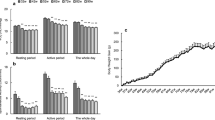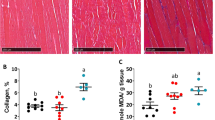Abstract
The effect of mild lifelong dietary restriction (DR) on age-related changes was investigated in rats. Histopathological findings were compared between 25-month-old male rats fed ad libitum and 25-month-old male rats that were calorie restricted (80% of ad libitum calories; protein 15%) from 9 weeks of age. DR-fed rats retained motor activity even in old age compared with ad libitum-fed rats. Histopathological studies on soleus muscles clarified myopathic changes in the ad libitum-fed rats, including variations in fiber size and an increase in the number of central nuclei. Increased non-grouping atrophic angulated fibers were also observed. The specimens revealed a confused arrangement of the mitochondria and decreased mitochondrial electron transduction enzyme activities, indicating mitochondrial insults in the ad libitum-fed rats. In contrast, no myopathic changes, little mitochondrial insult, and fewer angulated fibers were recognized in the DR-fed rats. The accumulations of heme oxygenase-1, αβ crystallin, 8-hydroxydeoxyguanosine, and heat shock protein 27 were recognized in ad libitum-fed rats, indicating the attack of oxidative stress. In contrast, the expressions of these proteins were suppressed in DR-fed rats. The results suggest that even mild calorie restriction is enough to attenuate oxidative stress and age-related morphological changes in skeletal muscle. Additionally, DR was effective in protecting against methylmercury-induced pathological changes. Small fiber size and suppression of mitochondrial electron transduction enzyme activities in skeletal muscle and degenerative changes in peripheral nerves were milder in methylmercury-exposed DR-fed rats. The results indicate that mild lifelong DR also protects skeletal muscle and peripheral nerves against a chemically-induced form of oxidative stress.






Similar content being viewed by others
References
Allman BL, Rice CL (2002) Neuromuscular fatigue and aging: central and peripheral factors. Muscle Nerve 25:785–796
Aly KB, Pipkin JL, Hinson WG, Feuers RJ, Duffy PH, Lyn-Cook L, Hart RW (1994) Chronic caloric restriction induces stress proteins in the hypothalamus of rats. Mech Ageing Dev 76:11–23
Bruce-Keller AJ, Umberger G, McFall R, Mattson MP (1999) Food restriction reduces brain damage and improves behavioral outcome following excitotoxic and metabolic insults. Ann Neurol 45:8–15
Chen K, Gunter K, Maines MD (2000) Neurons overexpressing heme oxygenase-1 resist oxidative stress-mediated cell death. J Neurochem 75:304–13
Dennery PA (2000) Regulation and role of heme oxygenase in oxidative injury. Curr Top Cell Regul 36:181–199
Duan W, Mattson MP (1999) Dietary restriction and 2-deoxy-glucose administration improve behavioral outcome and reduce degeneration of dopaminergic neurons in models of Parkinson’s disease. J Neurosci Res 57:195–206
Dubowitz V, Brooke, MH (1973) Muscle biopsy—a modern approach. Sanders, London, pp 20–33
Ehreafried JA, Evers BM, Chu KU, Townsend CM, Thompson JC (1996) Caloric restriction increases the expression of heat shock protein in the gut. Ann Surg 223:592–597
Guo Z, Ersoz A, Butterfield A, Mattson MP (2000) Beneficial effects of dietary restriction on cerebral cortical synaptic terminals: preservation on glucose and glutamate transport and mitochondrial function after exposure to amyloid β-peptide, iron, and 3-nitropropionic acid. J Neurochem 75:314–320
Heydari AR, You S, Takahashi R, Gutsmann A, Sarge KD, Richardson A (1996) Effect of caloric restriction on the expression of heat shock protein 70 and the activation of heat shock transcription factor 1. Dev Genet 18:114–124
Higuchi I, Niiyama T, Uchida Y, Inose M, Nakagawa M, Arimura K, Osame M (1999) Multiple episodes of thrombosis in a patient with Becker muscular dystrophy with marked expression of utrophin on the muscle cell membrane. Acta Neuropathol 98:313–6
Lowry OH, Rosenbrough NJ, Farr AL, Randall RJ (1951) Protein measurement with the Folin phenol reagent. J Biol Chem 193:265–275
Mattson MP, Duan W, Guo Z (2003) Meal size and frequency affect neuronal plasticity and vulnerability to disease: cellular and molecular mechanisms. J Neurochem 84:417–431
Morel Y, Barouki R (1999) Repression of gene expression by oxidative stress. Biochem J 342:481–496
Ryter SW, Tyrrell RM (2000) The heme synthesis and degradation pathways: role in oxidant sensitivity. Heme oxygenase has both pro- and antioxidant properties. Free Radic Biol Med 28:289–309
Shanker G, Aschner M (2003) Methylmercury-induced reactive oxygen species formation in neonatal cerebral astrocytic cultures is attenuated by antioxidants. Brain Res Mol Brain Res 110:85–91
Sohal RS, Weindruch R (1996) Oxidative stress, caloric restriction, and aging. Science 273:59-63
Sohal RS, Ku HH, Agarwal S, Forster MJ, Lal H (1994) Oxidative damage, mitochondrial oxidative generation and antioxidant defenses during aging and in response to food restriction in the mouse. Mech Aging Dev 74:121-133
Tabrizi SJ, Workman J, Hart PE, Mangiarini L, Mahal A, Bates G, Cooper JM, Schapira AHV (2000) Mitochondrial dysfunction and free radical damage in the Huntington R6/2 transgenic mouse. Ann Neurol 37:80–86
Usuki F, Ishiura S (1998) Expanded CTG repeats in myotonin protein kinase increase susceptibility to oxidative stress. Neuroreport 9:2291–2296
Usuki F, Yasutake A, Matsumoto M, Umehara F, Higuchi I (1998) The effect of methylmercury on skeletal muscle in the rat: a histopathological study. Toxicol Lett 94:227–232
Usuki F, Takahashi N, Sasagawa N, Ishiura S (2000) Differential signaling pathways following oxidative stress in mutant myotonin protein kinase cDNA-transfected C2C12 cell lines. Biochem Biophys Res Commun 267:739–743
Usuki F, Yasutake A, UmeharaF, TokunagaH, MatsumotoM, EtoK, Ishiura S, Higuchi I (2001) In vivo protection of a water-soluble derivative of vitamin E, Trolox, against methylmercury-intoxication. Neurosci Lett 304:199–203
Usuki F, Yasutake A, Matsumoto M, Higuchi I (2001) Chronic low-dose methylmercury administration decreases mitochondrial electron transport system enzyme activities and induces myopathic changes in rats. J Health Science 47:162–167
Yasutake A, Nakano A, Miyamoto K, Eto K (1997) Chronic effects of methylmercury in rats. I. Biochemical aspects. Tohoku J Exp Med 182:185–196
Yu ZF, Mattson MP (1999) Dietary restriction and 2-deoxy-glucose administration reduce focal ischemic brain damage and improve behavioral outcome: evidence for a preconditioning mechanism. J Neurosci Res 57:830–839
Yu BP, Lim BO, Sugano M (2002) Dietary restriction downregulates free radical and lipid peroxide production: plausible mechanism for elongation of life span. J Nutr Sci Vitaminol 48:257–264
Zhu H, Quo Q, Mattson MP (1999) Dietary restriction protects hippocampal neurons against the death-promoting action of a presenilin-1 mutation. Brain Res 842:224–229
Acknowledgments
We thank Professor Toru Iwaki, Kyushu University School of Medicine, for his kind gift of anti-αβ crystallin antibody. We also wish to thank Mr. Hidefumi Nishiyama for his helpful animal care and Ms. Noriko Hirata and Ms. Yuko Shirahama for their excellent technical assistance.
Author information
Authors and Affiliations
Corresponding author
Rights and permissions
About this article
Cite this article
Usuki, F., Yasutake, A., Umehara, F. et al. Beneficial effects of mild lifelong dietary restriction on skeletal muscle: prevention of age-related mitochondrial damage, morphological changes, and vulnerability to a chemical toxin. Acta Neuropathol 108, 1–9 (2004). https://doi.org/10.1007/s00401-004-0844-0
Received:
Revised:
Accepted:
Published:
Issue Date:
DOI: https://doi.org/10.1007/s00401-004-0844-0




